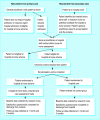Randomised controlled trial comparing hospital at home care with inpatient hospital care. I: three month follow up of health outcomes
- PMID: 9624068
- PMCID: PMC28578
- DOI: 10.1136/bmj.316.7147.1786
Randomised controlled trial comparing hospital at home care with inpatient hospital care. I: three month follow up of health outcomes
Abstract
Objectives: To compare hospital at home care with inpatient hospital care in terms of patient outcomes.
Design: Randomised controlled trial with three month follow up.
Setting: District general hospital and catchment area of neighbouring community trust.
Subjects: Patients recovering from hip replacement (n=86), knee replacement (n=86), and hysterectomy (n=238); elderly medical patients (n=96); and patients with chronic obstructive airways disease (n=32).
Interventions: Hospital at home care or inpatient hospital care.
Main outcome measures: Dartmouth COOP chart to measure patients' general health status; SF-36 to measure possible limitations in physical functioning of patients with hysterectomy; disease specific measures-chronic respiratory disease questionnaire, Barthel index for elderly medical patients, Oxford hip score, and Bristol knee score; hospital readmission and mortality data; carer strain index to measure burden on carers; patients' and carers' preferred form of care.
Results: At follow up, there were no major differences in outcome between hospital at home care and hospital care for any of the patient groups except that those recovering from hip replacement reported a significantly greater improvement in quality of life with hospital at home care (difference in change from baseline value 0.50, 95% confidence interval 0.13 to 0.88). Hospital at home did not seem suitable for patients recovering from a knee replacement, as 14 (30%) of patients allocated to hospital at home remained in hospital. Patients in all groups preferred hospital at home care except those with chronic obstructive airways disease. No differences were detected for carer burden. Carers of patients recovering from knee replacement preferred hospital at home care, while carers of patients recovering from a hysterectomy preferred hospital care.
Conclusions: Few differences in outcome were detected. Thus, the cost of hospital at home compared with hospital care becomes a primary concern.
Figures
Comment in
-
Acceptability of early discharge, hospital at home schemes. Treatments that can be safely and acceptably managed at home need to be defined.BMJ. 1998 Dec 12;317(7173):1652. BMJ. 1998. PMID: 9848914 Free PMC article. No abstract available.
-
Acceptability of early discharge, hospital at home schemes. Care in community hospitals is another alternative.BMJ. 1998 Dec 12;317(7173):1652-3. BMJ. 1998. PMID: 9917148 No abstract available.
References
-
- Audit Commission. The coming of age: improving care services for older people. London: Audit Commission; 1997.
-
- Shepperd S, Iliffe S. Hospital at home compared with in-patient hospital care [review] In: Bero L, Grilli R, Grimshaw J, Oxman A, editors. The Cochrane library. Cochrane Collaboration; Issue 1. Oxford: Update Software; 1998. (Updated quarterly.)
-
- Marks L. Home and hospital care: redrawing the boundaries. London: King’s Fund Institute; 1991.
-
- Galasko D, Klauber MR, Hofstetter R, Salmon DP, Lasker B, Thal LJ. The mini-mental state examination in the early diagnosis of Alzheimer’s disease. Arch Neurology. 1990;47:49–52. - PubMed
Publication types
MeSH terms
LinkOut - more resources
Full Text Sources
Medical

